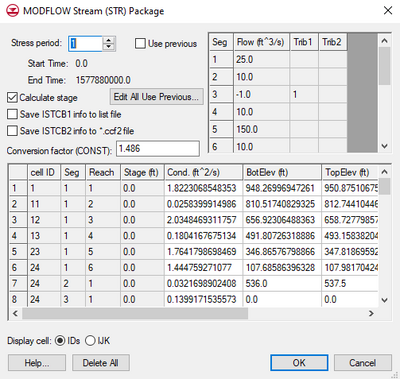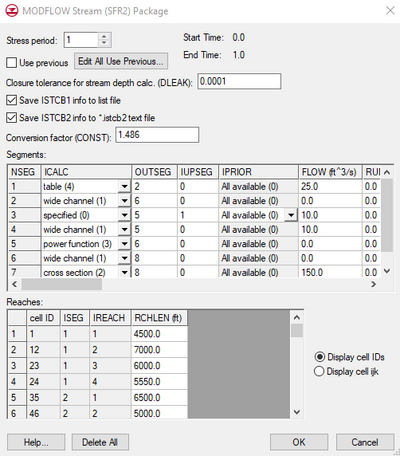GMS:STR/SFR Packages: Difference between revisions
From XMS Wiki
Jump to navigationJump to search
(Added links to documentation about the packages and clarified alternate initialisms for the packages) |
|||
| Line 1: | Line 1: | ||
{{MODFLOW Links}} | {{MODFLOW Links}} | ||
The Stream (STR) and Streamflow-Routing (SFR) packages are used to simulate the interaction between surficial streams and the groundwater. These packages are somewhat similar to the [[GMS:RIV Package|River package]] in that water can move from the stream to the aquifer or from the aquifer to the stream depending on the relative differences in the stream stage and the water table elevations. However, unlike the River package, flow is routed through the stream. For the STR package, simple channel hydraulics and Manning's equation are used to compute the stage in the stream. The SFR package has more sophisticated hydraulics and routing options. | The Stream (written STR, STR1 or SFR1) and Streamflow-Routing (written SFR or SFR2) packages are used to simulate the interaction between surficial streams and the groundwater. These packages are somewhat similar to the [[GMS:RIV Package|River package]] in that water can move from the stream to the aquifer or from the aquifer to the stream depending on the relative differences in the stream stage and the water table elevations. However, unlike the River package, flow is routed through the stream. For the STR package, simple channel hydraulics and Manning's equation are used to compute the stage in the stream. The SFR package has more sophisticated hydraulics and routing options. | ||
==Stream Network== | ==Stream Network== | ||
| Line 85: | Line 85: | ||
The stream flow out of each reach is stored in the ccf file under the heading STREAMFLOW_OUT. GMS can convert data in the CCF file to 3D grid datasets that can be contoured by right-clicking on the CCF file in the ''Project Explorer'' and using the ''CCF → Datasets'' command. If in the ccf file multiple flows are listed for the same cell, GMS sums them so that there is only one value for each cell in the resulting dataset. With most data this makes sense because the data represents the total flow into our out of the aquifer due to the BC (wells, river etc). The STREAMFLOW_OUT data is treated the same way, but in this case it doesn't make sense to sum the values because they don't represent flow to or from the aquifer. The problem becomes evident wherever there is more than one stream reach in a cell, which happens wherever a stream segment begins/ends in a cell. The STREAMFLOW_OUT dataset value will be the sum of all the reaches in the cell, which can make it appear as if much more water is flowing down the stream than there should be in that cell. If using SFR2, the user should save the istcb2 data as a text file (described above) which lists the streamflow out of each segment and reach separately. Despite this problem, the STREAMFLOW_OUT dataset can still be useful for contouring and display purposes. | The stream flow out of each reach is stored in the ccf file under the heading STREAMFLOW_OUT. GMS can convert data in the CCF file to 3D grid datasets that can be contoured by right-clicking on the CCF file in the ''Project Explorer'' and using the ''CCF → Datasets'' command. If in the ccf file multiple flows are listed for the same cell, GMS sums them so that there is only one value for each cell in the resulting dataset. With most data this makes sense because the data represents the total flow into our out of the aquifer due to the BC (wells, river etc). The STREAMFLOW_OUT data is treated the same way, but in this case it doesn't make sense to sum the values because they don't represent flow to or from the aquifer. The problem becomes evident wherever there is more than one stream reach in a cell, which happens wherever a stream segment begins/ends in a cell. The STREAMFLOW_OUT dataset value will be the sum of all the reaches in the cell, which can make it appear as if much more water is flowing down the stream than there should be in that cell. If using SFR2, the user should save the istcb2 data as a text file (described above) which lists the streamflow out of each segment and reach separately. Despite this problem, the STREAMFLOW_OUT dataset can still be useful for contouring and display purposes. | ||
==Documentation== | |||
* [http://pubs.usgs.gov/of/1988/0729/report.pdf STR Package Documentation 1989] | |||
* [http://pubs.usgs.gov/of/2004/1042/ofr2004-1042.pdf SFR Package Documentation 2004] | |||


